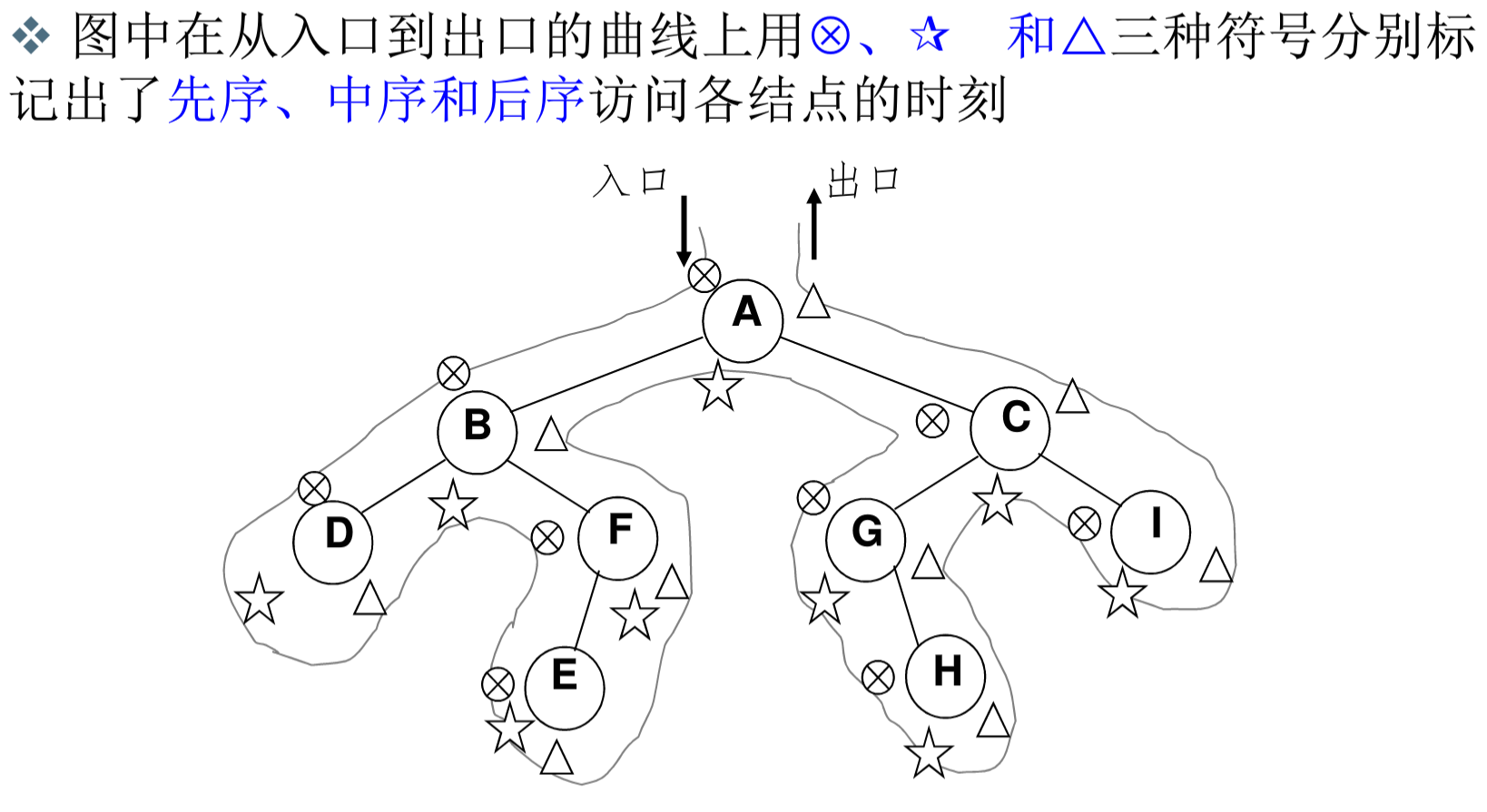二叉树基本操作
记录一下二叉树的基本常用操作,主要是前中后序遍历的递归/非递归解法、层序遍历的非递归解法以及如何根据前中后序确定二叉树。
数据结构定义
struct TreeNode {
int val;
TreeNode *left;
TreeNode *right;
TreeNode(int x) : val{x}, left{nullptr}, right{nullptr} {}
};
遍历
二叉树一般有四种遍历:前序、中序、后序和层序。
前中后序一般有递归和非递归两种实现方法,由于它们访问节点的路径是相同的,只是访问顺序不一样,因此这三种递归实现思路比较类似,而非递归实现则需要借助栈来实现(需要保存路径上经过但还未访问的节点)。
 图 1 前中后序遍历访问路径/访问顺序
图 1 前中后序遍历访问路径/访问顺序
层序遍历通常使用非递归实现,从它的访问顺序来看它也并不适合递归实现,层序遍历借助队列来实现(保存未来将要访问的节点,即下一层的孩子节点)。
前序遍历
递归实现
先访问根节点,然后依次访问左子树和右子树。
void preorder_rec(TreeNode *root) {
if (root) {
std::cout << root->data << " ";
preorder_rec(root->left);
preorder_rec(root->right);
}
}
非递归实现
使用栈保存路径上经过的节点(并访问输出),向左访问到最左子节点后弹出,然后访问右子树。
void preorder_nonrec(TreeNode *root) {
std::stack<TreeNode *> nodes;
while (root || !nodes.empty()) {
while (root) {
std::cout << root->data << " ";
nodes.push(root);
root = root->left;
}
root = nodes.top();
nodes.pop();
root = root->right;
}
}
中序遍历
递归实现
先访问左子树,然后访问根节点,最后访问右子树。
void inorder_rec(TreeNode *root) {
if (root) {
inorder_rec(root->left);
std::cout << root->data << " ";
inorder_rec(root->right);
}
}
非递归实现
跟前序非递归类似,但访问时机不一样。使用栈保存路径上经过的节点,向左访问到最左子节点后弹出(并访问输出),然后访问右子树。
void inorder_nonrec(TreeNode *root) {
std::stack<TreeNode *> nodes;
while (root || !nodes.empty()) {
while (root) {
nodes.push(root);
root = root->left;
}
root = nodes.top();
nodes.pop();
std::cout << root->val << " ";
root = root->right;
}
}
后序遍历
递归实现
先访问左子树,然后访问右子树,最后访问根节点。
void postorder_rec(TreeNode *root) {
if (root) {
postorder_rec(root->left);
postorder_rec(root->right);
std::cout << root->val << " ";
}
}
非递归实现
由于根节点需要在右子树访问完之后才访问,因此需要用一个变量保存上一次访问的节点。
void postorder_nonrec(TreeNode *root) {
TreeNode *last_node = nullptr;
std::stack<TreeNode *> nodes;
while (root || !nodes.empty()) {
while (root) {
nodes.push(root);
root = root->left;
}
root = nodes.top();
nodes.pop();
if (root->right == last_node || root->right == nullptr) {
// 右子树已经被访问过或者为空则直接访问当前节点
std::cout << root->val << " ";
last_node = root;
root = nullptr;
} else {
// 如果右子树还未访问则将当前节点重新压栈然后去访问右子树
nodes.push(root);
root = root->right;
}
}
}
层序遍历
层序遍历的规则显然非常适合使用 BFS,因此我们使用队列来完成遍历。
void levelorder(TreeNode *root) {
if (root) {
std::queue<TreeNode *> nodes;
nodes.push(root);
while (!nodes.empty()) {
root = nodes.front();
nodes.pop();
std::cout << root->val << " ";
if (root->left) {
nodes.push(root->left);
}
if (root->right) {
nodes.push(root->right);
}
}
}
}
由两种序列确定二叉树
有 前序+中序 和 后序+中序 两种组合,只有前序和后序序列是无法确定二叉树的。
理解前中后序序列顺序就很容易写出递归算法来构建二叉树了。
前序:根节点-左子树-右子树 中序:左子树-根节点-右子树 后序:左子树-右子树-根节点
根据前序和中序序列确定二叉树
首先根据前序序列找到根节点,即前序序列的第一个节点,然后在中序序列中找到根节点所在位置,这样就可以精确地获得左子树/右子树的 前序+中序 序列,递归地构建左右子树即可。
TreeNode *buildTree0(std::unordered_map<int, int> &inorder_map, std::vector<int> &inorder, std::vector<int> &preorder, int in_start, int pre_start, int node_size) {
/*
inorder_map: 保存 inroder 的值的 index 映射,这里假定节点没有重复值
inorder: 二叉树中序序列
preorder: 二叉树前序序列
in_start: 当前子树对应的中序序列在整个树的中序序列中的起始位置
pre_start: 当前子树对应的前序序列在整个树的前序序列中的起始位置
node_size: 当前子树的节点个数
*/
TreeNode *root = nullptr;
if (node_size) {
root = new TreeNode(preorder[pre_start]);
int root_index = inorder_map[root->val];
int left_len = root_index - in_start;
root->left = buildTree0(inorder_map, inorder, preorder, in_start, pre_start + 1, left_len);
root->right = buildTree0(inorder_map, inorder, preorder, in_start + left_len + 1, pre_start + 1 + left_len, node_size - 1 - left_len);
}
return root;
}
根据前序和中序序列确定二叉树
与 前序+中序 类似。
TreeNode *buildTree1(std::unordered_map<int, int> &inorder_map, std::vector<int>& inorder, std::vector<int>& postorder, int in_start, int post_start, int node_size) {
// 参数含义与 `前序+中序` 类似
TreeNode *root = nullptr;
if (node_size) {
root = new TreeNode(postorder[post_start + node_size - 1]);
int root_index = inorder_map[root->val];
int left_len = root_index - in_start;
root->left = buildTree1(inorder_map, inorder, postorder, in_start, post_start, left_len);
root->right = buildTree1(inorder_map, inorder, postorder, root_index + 1, post_start + left_len, node_size - 1 - left_len);
}
return root;
}